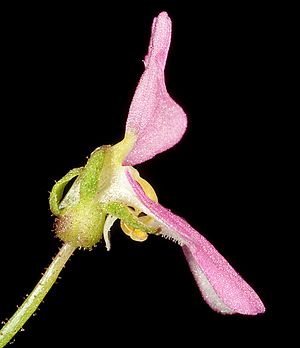Stylidium ecorne facts for kids
Stylidium ecorne is a special kind of plant that belongs to a group called Stylidium. It's a small plant that lives for about a year (an annual plant). It usually grows to be 5 to 12 centimeters (about 2 to 5 inches) tall. You can spot its pretty pale or bright pink flowers in wet, swampy areas.
Quick facts for kids Stylidium ecorne |
|
|---|---|
 |
|
 |
|
| Scientific classification | |
| Genus: |
Stylidium
|
| Species: |
ecorne
|
| Synonyms | |
|
S. calcaratum var. ecorne
|
|
Contents
How Stylidium ecorne Got Its Name
Scientists group and name plants to understand them better. This is called taxonomy. The plant S. ecorne has an interesting naming story.
A scientist named Ferdinand von Mueller first found S. ecorne. But he didn't give it its own specific name. Later, in 1956, two other scientists, Rica Erickson and Jim Willis, studied a similar plant called Stylidium calcaratum. They noticed that S. ecorne was a bit different. They decided to call it a "variety" of S. calcaratum, naming it S. calcaratum var. ecorne.
Why S. ecorne Became Its Own Species
Erickson and Willis thought S. ecorne looked very much like S. calcaratum. The main difference was a part of the flower called the nectary spur. This spur was much smaller or missing in S. calcaratum var. ecorne.
In 1979, two more scientists, Pauline G. Farrell and Sydney Herbert James, looked closer at these plants. They found big differences in their chromosomes (the tiny parts inside cells that carry genetic information) and how they reproduce. Because of these differences, Farrell and James decided that S. ecorne should be its own separate species.
Key Differences Between S. ecorne and S. calcaratum
Farrell and James found that S. ecorne has 13 chromosomes in its reproductive cells. But S. calcaratum has only 11. Scientists think that S. calcaratum likely evolved from S. ecorne over time. This change also led to S. calcaratum having fewer seeds and being able to grow in more places.
When scientists tried to cross S. ecorne and S. calcaratum (like trying to make them have baby plants together), they got very few seeds. This showed that the two plants are quite different and don't easily mix.
Here are some of the main differences:
- Nectary Spur: In S. calcaratum, the spur is at least as long as the leaf-like part below it. In S. ecorne, it's shorter or completely missing.
- Number of Ovules: S. calcaratum has about 85 ovules (which become seeds) per flower. S. ecorne has many more, around 466 ovules per flower.
- Chromosome Number: S. calcaratum has 11 chromosomes in its reproductive cells. S. ecorne has 13.
- Habitat: S. calcaratum can grow in many places like swamps, wet mossy areas, dry sandy soils, or along roads. S. ecorne is pickier and only grows in swampy or wet mossy areas.
Where Stylidium ecorne Lives
S. ecorne can be found in many of the same areas as S. calcaratum. However, it is less common because it needs very specific wet, swampy places to grow.
You can find S. ecorne in Western Australia, starting north of Geraldton and going south to Mount Chudalup. It also grows east through South Australia into western Victoria. There are even a few small groups of these plants further east near Gembrook and Violet Town.

